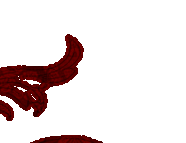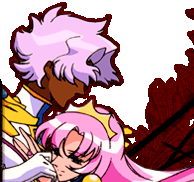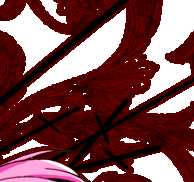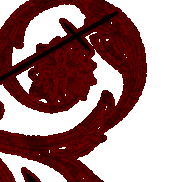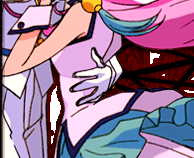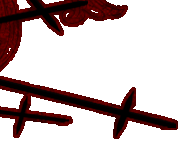
This analysis
was donated by seebee. 
Vanna's Note: This essay is a work that Yasha and I were specifically interviewed for. The result is a touching, empowering piece of writing that has honestly helped redirect and renew my passion for Utena and the fandom. It means a lot to me, having had this written at a point in my life where I was struggling a lot. Thank you for this, seebee!
 I watched the last episode of Revolutionary Girl Utena like I was seeing fire for the first time. The 1997 anime ends with the two main characters, Utena and Anthy, leaving an abusive environment to create a different future together. Their future begins by dreaming of a past together: the last shot is a sepia-toned close-up of the two girls holding hands. Their utopia begins by archiving what’s in reach – each other. Before I watched Utena, I knew queer archiving was important, but personally, I’d never felt connected to the past before. As my laptop screen faded to black, the image of Anthy and Utena’s hands still burned behind my eyelids. Seeing queer bodies shine in a series made almost 25 years ago, I felt something luminous and dangerously hopeful bloom inside me. It dreamt of the past while feeling homesick for the future. The queer past I’d been searching for was inside my body the whole time, and now it was awake.
I found Utena – or, Utena found me – while I was looking for a queer form of storytelling that I could use to understand my own life. I knew my life was too messy and too queer to form a nice gay story, so I tried to break off one memory at a time and smooth it down until it became a self-contained, self-explanatory Truth. But doing that was like digging in sand; every time I thought I’d gotten somewhere, it would collapse in on itself.
Utena doesn’t fit neatly into any categories of pre-existing storytelling methods. The only way I can describe it in words is to say it’s an embodying narrative: refusing to be self-contained or self-explanatory, it positions the audience to understand it through their own body. It’s important to say that there’s a difference between embodied and embodying narratives. The first treats embodiment as a performative device – its goal is to make the audience feel like they’re in the body of the narrator. The second treats embodiment as an analytical practice – its goal is to make the audience listen to their own body. It forces the viewer to think critically about media and themselves, and to become their own storytellers. Embodying narratives also don’t have to be limited to fiction. It’s a queer form of storytelling that should be embraced everywhere, but most of all in archives.
Created by Ikuhara Kunihiko, a director known for making dense and trippy queer anime, every episode of Utena contains so many references that I couldn’t understand it until I read fan analysis. The thing is, you can watch Utena alone, but you can’t understand Utena alone. That means the body of work analyzing Utena forms the body of Utena itself. It’s a body that’s limitless, unlinear, always expanding, always shape-shifting. It’s a queer body. It moves in queer patterns. When you critically engage with it, your body becomes a part of it too. It’s like a dance – if you want to experience it fully, you can’t sit on the sidelines watching it happen. Every piece of Utena analysis is a retelling of the story through the body of the person who’s writing it.
It feels fitting that the longest-running Utena archive in the English language is curated by a couple. And not just that, but a lesbian couple who met through Utena. Yasha got into anime in the late 90s, when her group of guy friends at school told her it was “more addictive and more expensive than drugs.” Giovanna got into anime around the same time, and waited to watch Utena until she’d burned through every other bootlegged anime she could get her hands on. Telling me she has a penchant for dark shit, I can see how the Pepto-Bismol-pink cover of the Utena VHS was a turn-off.
If you make it past the front cover, you’ll find that Utena is, in fact, dark shit. The anime is about breaking free from abuse, so it checks off almost every trigger warning you can imagine, in almost every way you can imagine it. It’s not trauma porn though – Ikuhara knows the power of the viewer’s imagination, and he uses it to provide the most thorough analysis of gender, sex, and sexuality I’ve ever seen. But you might not assume that by looking at it. To be honest, it’s a fever dream. Using a palette of psychedelic colours, the characters dress like European royalty, fight boxing kangaroos, poison each other with cantarella, lay eggs, and turn into cows. Utena is campy and theatrical and so, so queer.
Despite her doubts, Giovanna gave Utena a shot. By the early 2000s, she was spending 8 hours a day coding a website called Empty Movement, a shrine to the show and to the fandom around it. Facing burnout, she told the fandom online she was thinking of quitting, and got angry feedback from other fans who wanted her to keep doing the work they wanted done. Yasha sent Giovanna an email to tell her she should do what she wanted, and not listen to what anybody else has to say. When I asked Yasha if she remembered when she sent that email, she told me immediately – it was November 22nd, 2002.
Today, Giovanna and Yasha are a married couple, and Empty Movement is over 20 years old. They keep it up to date with every piece of the Utena-related material they can find. Valuing official and fan-made media alike, their website is home to essays, scripts, interviews, articles, and The Gallery: an exhaustive collection of over 13,000 screencaps, production artwork, backgrounds, sketches, sheet music, and more. Yasha told me that at a low estimate, it would take Giovanna about an hour to clean up one image on Photoshop. To prepare the whole gallery took two years of work.
I talked with Giovanna and Yasha separately, but I didn’t need to see them in the same Zoom frame to pick up on the similarities. They were both white women who looked to be in their mid-30s, with long, dark, and straight hair. But it was more about the way they moved – the cadence of their voices, the way they nodded, and the way they laughed, quietly and quickly and always after their own jokes. Their bodies spoke loudest in the language of each other, and every echo reminded me how much time that must have taken. Their bodies told me they approach their relationship to each other and to archiving the same way – with the dedication of time.
When I asked the couple why they felt compelled to archive Utena, they both talked about feeling bad for not having the time to archive other subjects – other pieces of queer media, other moments in queer herstory. “It feels like we're always trying to pick up the pieces of our last generation that got left behind, got covered up,” Giovanna told me. “We're constantly having to excavate our own history because it keeps getting buried.”
In his 1996 essay “Ephemera as Evidence,” José Esteban Muñoz argued for the need to work with and from ephemera in queer archives. To Muñoz, queerness has always existed as “innuendo, gossip, fleeting moments, and performances” rather than as a visible, permanent, loudly stated Truth. So if you want to archive queerness, you need to follow the ephemeral – the traces of something left behind, “all of those things that remain after a performance.” In the open space after a narrative is finished, that’s when we can start to pick up the sticky threads that Muñoz describes as queer ephemera.
Because queer archiving is dealing with the traces of queerness, but not actually queerness itself, it’s always an act of dreaming. Queer archiving affirms that we exist in a time other than the present. It imagines there will be queer kids in the future who want to understand their past, and it dreams of a future where all of us feel connected to that past. It’s about following that luminous seed of queer ephemera back to the future.
Queer archiving is queer futurism. That’s what makes queer archiving so powerful, and that power is why some queer scholars are so afraid of it. In his book No Future, Lee Edelman sets up an epic battle between queerness and the future. Edelman claims we only have one possible future, and it’s more queer suffering under the narrative of capitalism. In this narrative, Edelman says that children represent the pinnacle of success – so if we want to rewrite this future, all we can do in the present is adopt an anti-social way of life. In Freudian theory, this desire for destruction is called the death drive. Edelman’s perspective lacks any hope for the future at all, and that lack of hope kills queer futurism in its cradle. When we exist in a queerphobic culture, the choice to distance ourselves from queer children only guarantees that we’ll have no future. As Muñoz reminds us in his debate with Edelman on the subject, “racialized kids, queer kids, are not the sovereign princes of futurity.”
In Utena, Ikuhara imagines a queer of colour future where there are no princes at all. He imagines a future without set narratives of success, and he does so by following the relationship between Utena and Anthy. At the end of the series, Utena realizes that princehood is an illusion, but before then it’s her entire existence – she dresses like a prince, fights like a prince, and collects princesses, like Anthy. She believes that being revolutionary means being a girl in a boy’s role. In the last episode, Utena realizes that they can only escape their current reality if she throws down her sword, and reaches for Anthy’s hand.
“Utena doesn't become a prince because the world doesn't need princes, the world needs friends. The world needs intimacy. The world needs support,” says Giovanna. Our future doesn’t need princes, and I don’t think our future wants them either. When I listen to what my body wants for the future, it’s not seeing marginalized people folded into the systems we already have in place. My body wants to feel friendship, intimacy, support. Muñoz describes ephemera as being “firmly rooted within the social.” If we believe in ephemera as evidence, and believe in archiving as futurism, then we already know how to access our queerest futures. We’ll move forward by moving within, moving deeper, and moving together with embodying narratives.
Drawing on Black feminist thought in her book Pleasure Activism, adrienne maree brown writes about “the politics of feeling good” – of letting pleasure guide the ways that we activate, organize, and dream of new worlds. In the introduction, she writes, “our radical imagination is a tool for decolonization, for reclaiming our right to shape our lived reality.” Rather than beginning from a place of state politics, brown reminds the reader that revolutions are born in our imagination, and they need to be centered on pleasure. At the end of the series, we don’t see the outside world that Utena and Anthy escape to – we just see their hands. The point of the show is not to dictate exactly what utopia looks like, but to say that the only path to that utopia is through pleasure.
In my conversation with Giovanna and Yasha, they both agreed that Utena analysis is generally a “film studies jerk off.” The author is always feeling themselves during it – but there’s a difference between keeping that discourse in your mind or your desk drawer, and sharing it where anyone on the Internet could find it. There’s a different kind of pleasure that comes with having a voyeur, hoping someone will find you and see you and respond in kind. When someone chooses to publicize Utena analysis, they’re doing it because they hope it’ll bring other people pleasure, too. This is something Yasha mentioned, talking about the motivations of people who come to Empty Movement looking for a platform to host their analysis: “A lot of their enthusiasm comes from imagining how other people will receive it, and imagining the kinds of conversations they might have because of it.” Even as we laughed at the navel-gazing nature of most Utena analysis, Giovanna said the series acts as “a shared language for self-exploration.”
Throughout Pleasure Activism, brown continually returns to Audre Lorde’s essay, “The Erotic as Power.” In it, Lorde asks us to listen to our body’s yes! in activism, academia, and any other area of our life that we normally isolate from pleasure. She writes about how there’s no difference to her between writing a good poem and moving into sunlight against the body of a woman she loves. Lorde tells us, “The erotic is the first and most powerful guiding light toward any understanding.” In Freudian theory, this desire for life-affirming energies, both sexual and creative, are in direct opposition to the death drive. Considering Muñoz’s debate with Edelman, it becomes clear that Muñoz and Lorde were speaking of the same philosophy: of letting our bodies guide us toward understanding our past, our future, ourselves, and each other.
When I was talking to Yasha about this idea of pleasure-led lives, she was quiet for a moment, and then asked me if I’d ever thought about how hard it is to really know a person.
“How can you understand somebody without learning every little thing there is to know about them? The way their mind works, the way their skin smells…” Yasha said. “I guess that’s what they mean when they say love, huh?”
Later in our conversation, as I was trying to express what I was feeling, digging so deep into this project, I found myself at a loss for words. I was trying to say that I’ve realized I’ll be returning to these questions, again and again, maybe for the rest of my life. Even writing it out here, I can’t convey the feeling of it in words. The sensation of it. I started drawing a circle in the air with my finger, starting big and spinning closer and closer the further it went down. In that moment, I couldn’t think of any words that felt right, but my body knew what it was trying to say. All I needed was to have another person there, someone listening to what my body was saying.
Yasha smiled as she watched my hand. “That’s a revolution.”
In the creator commentary for the final episode of Utena, Ikuhara says, “Revolution means gaining the power to imagine the future.” When we imagine a better future together, that revolution sends ripples back in time. By imagining a fictive someday where our lives are guided by pleasure, we also imagine our past and our present differently. We can begin to tell and re-tell our lives as embodying narratives. And when we do that, we listen to our bodies differently. When we live embodying narratives, we feel the act of love as a commitment to understanding, and we see that understanding is a revolutionary process. When we live embodying narratives, utopia waits in the space between our hands.

Works Cited
brown, adrienne maree. Pleasure Activism. Chico: A.K. Press, 2019.
Ikuhara, Kunihiko, dir. Revolutionary Girl Utena: Adolescence of Utena. 1997; Japan: J.C. Staff. https://www.funimation.com/shows/revolutionary-girl-utena-adolescence-of-utena/
José Esteban Muñoz. “Ephemera as Evidence: Introductory Notes to Queer Acts.” Women & Performance 8:2, 5-16 (1996), doi: https://doi.org/10.1080/07407709608571228
Revolutionary Girl Utena. Directed by Ikuhara Kunihiko. 1997; Japan: produced by J.C. Staff, distributed by Nozomi Enterainment. https://www.funimation.com/shows/revolutionary-girl-utena/
Ruti, Mari. The Ethics of Opting Out. New York: Columbia University Press, 2017.

 |


